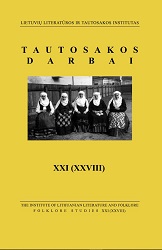Hansas Christianas Andersenas ir folklorinė pasaka
Hans Christian Andersen and the Folkloric Tale
Author(s): Asta GustaitienėSubject(s): Customs / Folklore, Other Language Literature, 19th Century, Theory of Literature
Published by: Lietuvių literatūros ir tautosakos institutas
Keywords: Hans Christian Andersen; Folklore; Tales; Danish literature;
Summary/Abstract: On the basis of numerous academic studies, referable to this thematical paradigm, the author of the article reveals connections of the small prose by H. C. Andersen with the folkloric tale. One of the tendencies of the Danish golden age (1800–1850) is pointed out, namely, that of studying and popularizing the folk tales, as well as encouraging creation of the literary ones. Major attention is devoted in the article to the analysis and evaluation of seven tales by H. C. Andersen composed on the basis of folk tales. These 7 literary tales, i.e. The Tinder Box, Jack the Dullard, The Wild Swans, The Traveling Companion, What the Old Man Does Is Always Right, Little Claus and Big Claus, The Swineherd, are analyzed extensively. Analysis and comparison of extracts from one of these compositions, i.e. The Swineherd (Svinedrengen) and the folk tale The Conceited Maiden (Den stolte jomfrue) are also presented. Having considered all the small prose by H. C. Andersen, i.e. 156 compositions, his attitude to certain conventions typical for the folkloric tale, is highlighted. Interactions of H. C. Andersen’s work with the folk tales are bi-directional. During the early period of his creativity, while composing the literary tales H. C. Andersen directly followed patterns of the folkloric tale, whereas later variants of the tales created by H. C. Andersen himself started spreading and were told as folk tales. In this respect, tales The Traveling Companion and What the Old Man Does Is Always Right became especially popular. H. C. Andersen consciously used many conventions typical for the folkloric tales, e.g. the magical numbers, the stereotypical non-individualized characters, the beginning formulae (“Once upon a time”, “Once in a village”, etc.), and the unspecified place of action, yet distancing himself from the typical ending formulae of the folkloric tales, as well as from their habitual happy endings, applying deep psychological insight instead. Unlike folkloric tales, H. C. Andersen most frequently used the present tense instead of the past, probably regarding the present as more suitable for the magical manifestations and for the fairy tales in general. Also his conscious strategy included framing the story into another narrative.
Journal: Tautosakos darbai
- Issue Year: 2005
- Issue No: 30
- Page Range: 218-233
- Page Count: 16
- Language: Lithuanian

